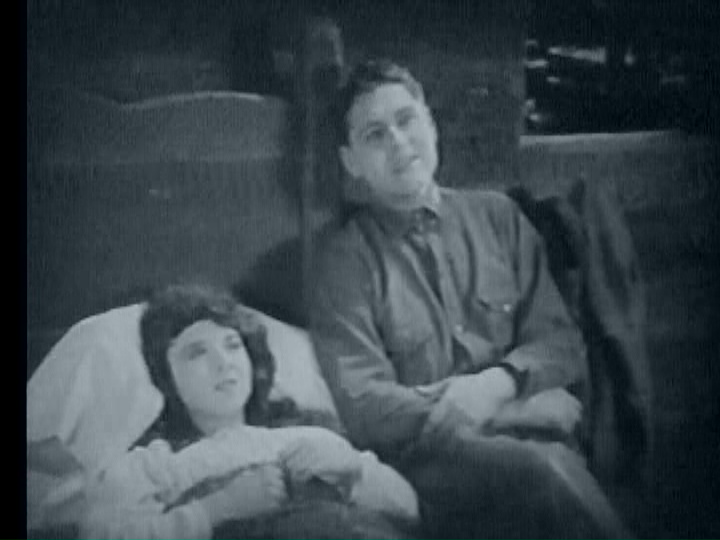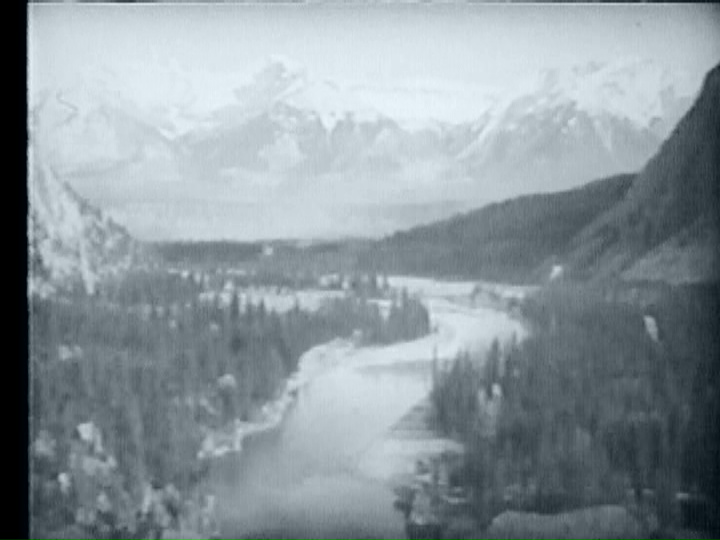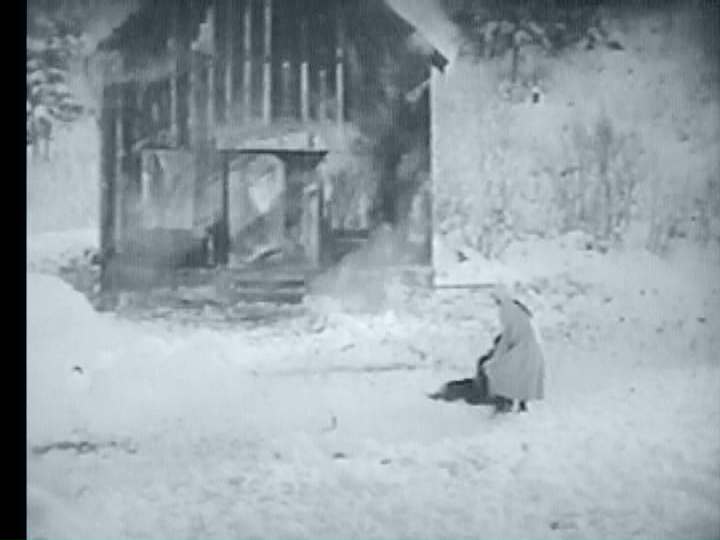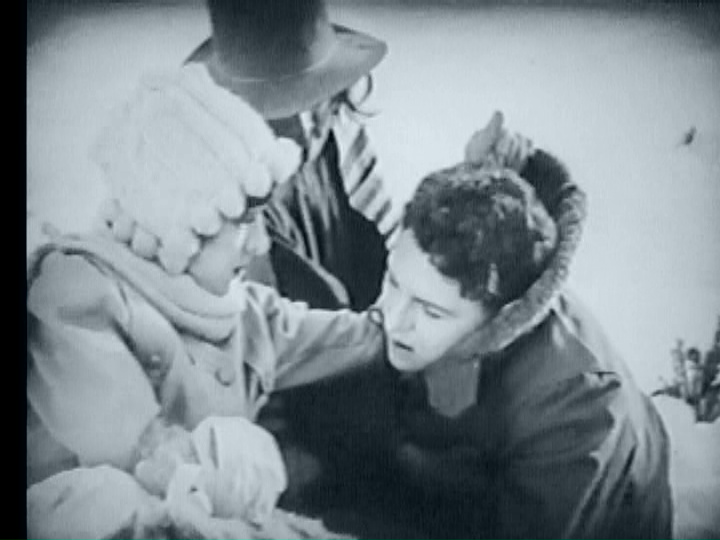A missionary arrives in the Rocky Mountain Foothills and finds a less-than-warm welcome from the locals. “The Sky Pilot” takes a job at a ranch in hopes of proving himself and being accepted by his would-be parishioners. Colleen Moore is featured as a madcap atheist.
Home Media Availability: Released on DVD.
Unflappable
Over a century ago, a team of filmmakers trekked up to Truckee, California to shoot a Northern picture, a drama set in Canadian cattle country. Canadian pictures were big business for Hollywood with William S. Hart jumping in with Blue Blazes Rawden, Back to God’s Country raking in the box office cash and even Lon Chaney getting in on the act with Nomads of the North.
The Sky Pilot distinguished itself with a religious tone (“sky pilot” being slang for a minister) and was based on the novel of the same name by Ralph Connor. However, it’s probably best remembered today for the two biggest names involved in the production: director King Vidor and leading lady Colleen Moore in her pre-flapper days.
Vidor would go on to direct some of the biggest hits of the silent era (The Big Parade, La Boheme) as well as two of Marion Davies’ finest films (The Patsy and Show People), so it’s fun to rewind and see how it all began.
John Bowers plays Arthur Wellington Moore a.k.a. the Sky Pilot, a Montreal-educated minister on a mission to bring religion to the small cattle settlement of Swan Creek. The locals refuse to listen and run him out of town but cowpoke Bill Hendricks (David Butler) decides to help the Sky Pilot out. If he can establish himself as a friend and neighbor before trying to preach, he will likely be more successful and the Sky Pilot takes a job at a nearby cattle ranch.
Bill is courting Gwen (Colleen Moore), who lives with her father, the Old Timer (Harry Todd). The Old Timer’s wife died and he experienced a crisis of faith; he and his daughter are now both atheists. Gwen is friendly with the Sky Pilot at first but rejects him when she discovers his true profession.
There is dirty work afoot and Gwen finds out that her father is planning to assist in a massive cattle rustling scheme. She races out to stop the plot in its tracks. She is thrown from her horse in the path of the stampeding cattle and is only saved when the Sky Pilot shields her. She lives but she loses the loss of her legs and her doctors believes that the paralysis is permanent. Her father breaks down and prays for the first time in years.
Gwen descends into despair and nobody is able to pull her out of it until the Sky Pilot sits down with her and offers comfort. With his help, she begins to accept her new circumstances. I rather liked this part of the film and was pleased that a studio production opted to portray a character dealing with hardships and not expecting a miraculous rescue. (More on this later.)
The Sky Pilot slowly gains the trust and affection of the cattle town residents and they even surprise him with a new church but the cattle rustlers haven’t finished with their scheming. Will the Sky Pilot survive their revenge? Will Gwen continue her emotional recovery? See The Sky Pilot to find out.
It’s easy to see why King Vidor was seen as a hot young talent. The Sky Pilot has heft and emotional maturity that one would normally associate with an older director. Vidor was only twenty-six when he directed the picture but had a few years of experience in shorts and features under his belt and an appreciation for the great outdoors that is evident in the finished picture.
While I liked the first two-thirds of the film, I have serious issues with the screenplay and most of them are loaded into the last reel, so if you don’t want to see any spoilers, consider this to be your warning.
I mentioned earlier that I was pleased by the way the Sky Pilot helps Gwen deal with her understandable depression after her accident. Instead of flashy miracles, our minister offers practical comfort that helps a young woman accept a challenging diagnosis. Well done, well done, indeed.
Yeah, about that…
The film ends with the Sky Pilot being shot by cattle rustlers, trying to save his bible from a burning church and collapsing in the doorway. Gwen sees his peril, drags herself to the door and then (angelic chorus) stands up and pulls him to safety. It all ends with a wedding between the ex-atheist and the Sky Pilot.
This ending was invented for the film adaptation. The novel by Ralph Connor (a pseudonym of Charles William Gordon, himself a Presbyterian minister) ends with Gwen still paralyzed but guided to acceptance by the Sky Pilot, who falls ill and dies at the conclusion of the book. It’s one of those bittersweet, semi-downer endings (with bonus “too good for this world”) that feelgood novelists of the period liked to spring on their readers but it all makes narrative sense.
I honestly resent the way the film resolved its main conflicts. It feels cheap. Even Pollyanna had to receive physical therapy to regain her ability to walk, for heaven’s sake. The film’s implication that people who do not miraculously regain the ability to walk just didn’t pray hard enough is bad enough but, let’s face it, as movie endings go, this has enough cheese and corn for a year’s supply of nachos. In fact, I would call this a textbook example of a slapped-on Hollywood happy ending collapsing the entire celluloid edifice.
Honestly, I am halfway to convincing myself that the ending was actually the dying dream of the Sky Pilot as he lay bleeding out in the snow. A downer ending, to be sure, but a more honest one. Give me an honest and depressing ending over an unearned happy one any day of the week.
It’s probable that the happier and more marketable ending was King Vidor’s way of assuring that the picture would turn a much-needed profit. Vidor had been attempting to establish himself as a semi-independent with a facility called Vidor Village being backed by First National. It’s also possible that the happy and more miraculous ending was meant to please producer Cathrine Curtis, whose reactionary, isolationist political views would later make her infamous.
The decision to shoot the snow scenes in Truckee pushed The Sky Pilot over budget and Vidor was obliged to ask the cast and crew to complete with picture without pay. In his memoirs, A Tree is a Tree, Vidor shared his frustrations with the uncooperative Truckee snow. (He also declined to name Curtis as his financial backer.) An unseasonably early storm forced the crew to shovel the stuff away from their sets and then let it build up again for subsequent scenes. There’s no denying the power of the resulting images, however, and the church burning against the white backdrop is still stunning a century later.
The film’s other strength is the charisma of a young Colleen Moore. Barely out of her teens and already a veteran performer, Moore was not yet established as a flapper but she brought the energy and spunk of young twenties womanhood to the role of Gwen. Running, jumping, racing and riding for the first part of the picture, Moore emotes a bit heavily the quieter scenes after her character’s accident but she’s still very good.
A 1922 issue of Motion Picture Magazine profiled Moore and stated that her mother had forbidden her to ever bob her hair, come what might. So, Moore got around the ban by tucking her curled hair under in a faux bob. Moore’s iconic straight bob would not be seen for at least another year.
Leading man John Bowers has always seemed a bit on the bland side to me and he is usually mentioned in relation to his tragic death in 1936. The Sky Pilot is one of his better performances with Bowers striking a balance between the spiritual and secular worlds and managing to convey piety without sanctimony. No easy task.
In general, both the direction and performances are better than the screenplay and while The Sky Pilot has its strong points, its cop-out ending is a major detraction. Fans of Vidor and Moore will want to check this one out but it could have been better.
Where can I see it?
There’s a bargain basement DVD release but I am hoping for something nicer in the future. This film deserves HD.
☙❦❧
Like what you’re reading? Please consider sponsoring me on Patreon. All patrons will get early previews of upcoming features, exclusive polls and other goodies.
Disclosure: Some links included in this post may be affiliate links to products sold by Amazon and as an Amazon Associate I earn from qualifying purchases.











You mentioned Colleen’s ‘snow day costume,’ which reminded me of one of the things I liked best about this film (besides seeing one of my favorite stars in an early role.) Frontier women are so often costumed in plaid shirts, jeans or riding skirts, and broad-brimmed hats, that the winter clothes made a pleasant change. Where can I buy that cap?
Isn’t it great?